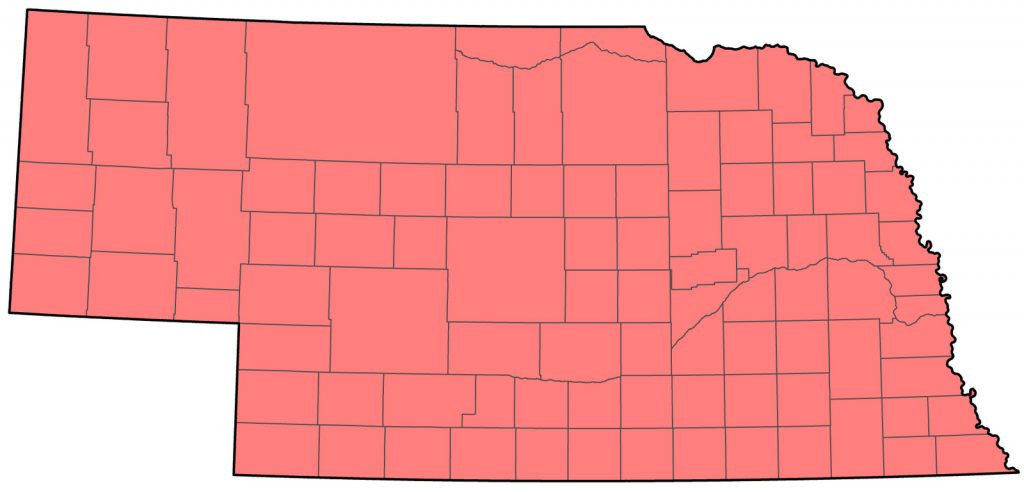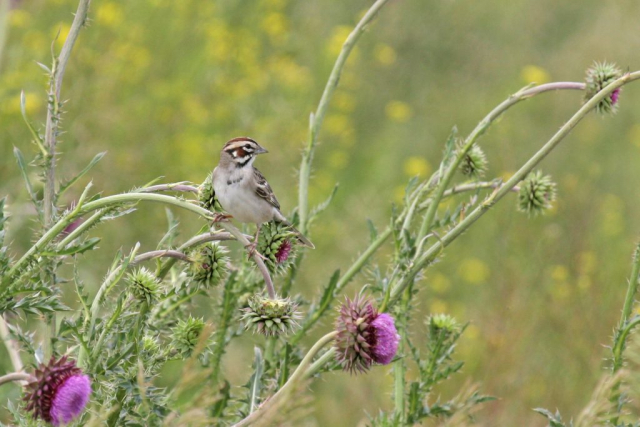Chondestes grammacus grammacus, C. g. strigatus
Status: Common regular breeder and spring and fall migrant statewide.

Documentation: Specimen: strigatus, UNSM ZM7348, 16 Jun 1901 Badlands, Sioux Co; grammacus, UNSM7353, 16 May 1914 Cass Co.
Taxonomy: Two subspecies are recognized (AviList 2025): strigatus, breeding from British Columbia to Manitoba south to California and west Texas, wintering California to Florida, and grammacus, breeding from Minnesota and east Texas east to Pennsylvania and Georgia, wintering from southeast Texas to Florida.
According to Bruner et al (1904), grammacus breeds in eastern Nebraska west to the 98th meridian [just east of Grand Island], while birds breeding elsewhere in the state are strigatus. Swenk (Notes Before 1925) noted that specimens taken in the Kearney, Buffalo Co area were mostly strigatus. This suggests that grammacus is the breeding subspecies of the original tallgrass prairie area, while the rest of the state is occupied by strigatus. It is likely that most birds in at least central Nebraska are intergrades.
Pyle (2025) synonymized strigatus and grammacus based on their not meeting the generally accepted 75% rule for subspecies diagnosability.
Nebraska breeders within the range of strigatus have been separated as quillini, but differences are slight, and this taxon is not currently recognized; these birds are probably best considered intergrades (Pyle 1997).
Spring: Apr 8, 8, 9 <<<>>> summer
Earlier dates are 23 Mar 2009 Hall Co, 1 Apr 2016 Richardson Co, 5 Apr 2016 Rock Co, and 6 Apr 2022 Saunders Co.
Migrants usually arrive in mid-Apr.
- High counts: 900 in Chase Co around 1 May 1999, 155 at Calamus Reservoir, Loup Co 7 May 2005, 130 in East Ash Canyon, Dawes Co 17 May 2017, 120 at Fort Robinson SHP, Dawes Co 20 May 2015, and 120 at Oliver Reservoir, Kimball Co 4 May 2024.
Summer: Lark Sparrow breeds statewide and is “our most common sparrow” in the summer breeding season (Mollhoff 2016). They can be abundant in the Sandhills, particularly in pastures where low shrubs such as yucca are found. Numbers have increased in the east since 2001 (Mollhoff 2001, 2016), where it is now as common as in most of the rest of the state. As of 2012, there had been no documented breeding records in the eastern Rainwater Basin (Jorgensen 2012, Mollhoff 2016), although there have been numerous summer records there since.
- Breeding phenology:
Copulation: 17-27 May
Nest building: 14 May- 10 Jul
Eggs: 6 Apr- 24 Jul (Mollhoff 2022)
Nestlings: 20 May-29 Jun
Fledglings: 15 Jun-30 Jul
- High counts: 130 in the Lake McConaughy, Keith Co area 22 Jun 2002 and 118 at Crescent Lake NWR, Garden Co 26 Jul 1995.
Fall: summer <<<>>> Oct 23, 24, 25
Later dates are 30 Oct 2020 Lancaster Co, 31 Oct 2020 Lancaster Co, and 4 Nov 2008 Otoe Co. One caught by a cat in a Valentine, Cherry Co area yard 29 Nov 2023 had a deformed lower mandible. Very late was one photographed in Saunders Co 14-19 Dec 2020.
Summering birds departed James Ranch, Sioux Co, 21 Aug 1995; adults may depart breeding grounds as early as mid-Jul or Aug (Rosenberg et al 1991, Martin and Parrish 2020). Migration ends by mid-Oct.
There are two CBC reports without documentation, likely misidentifications. There is only one documented Dec or winter record, although two were reported in South Dakota at the Gavin’s Point Dam area 12 Feb 2011.
- High counts: 150 in Carter Canyon, Scotts Bluff Co 6 Aug 2023, 89 in southwest Kimball Co 2 Sep 1999, 75 at Cedar Vue, Lake McConaughy, Keith Co 29 Aug 2024, and 70 at Oliver Reservoir, Kimball Co 10 Aug 2021.
Images
Abbreviations
CBC: Christmas Bird Count
NWR: National Wildlife Refuge
SHP: State Historical Park
UNSM: University of Nebraska State Museum
Literature Cited
AviList Core Team, 2025. AviList: The Global Avian Checklist, v2025. https://doi.org/10.2173/avilist.v2025.
Bruner, L., R.H. Wolcott, and M.H. Swenk. 1904. A preliminary review of the birds of Nebraska, with synopses. Klopp and Bartlett, Omaha, Nebraska, USA.
Jorgensen, J.G. 2012. Birds of the Rainwater Basin, Nebraska. Nebraska Game and Parks Commission, Lincoln, Nebraska, USA.
Martin, J.W. and J.R. Parrish. 2020. Lark Sparrow (Chondestes grammacus), version 1.0. In Birds of the World (A. F. Poole and F. B. Gill, Editors). Cornell Lab of Ornithology, Ithaca, NY, USA. https://doi.org/10.2173/bow.larspa.01.
Mollhoff, W.J. 2001. The Nebraska Breeding Bird Atlas 1984-1989. Nebraska Ornithologists’ Union Occasional Papers No. 7. Nebraska Game and Parks Commission, Lincoln, Nebraska, USA.
Mollhoff, W.J. 2016. The Second Nebraska Breeding Bird Atlas. Bull. Univ. Nebraska State Museum Vol 29. University of Nebraska State Museum, Lincoln, Nebraska, USA.
Mollhoff, W.J. 2022. Nest records of Nebraska birds. Nebraska Ornithologists’ Union Occasional Paper Number 9.
Pyle, P. 1997. Identification Guide to North American Birds. Part I, Columbidae to Ploceidae. Slate Creek Press, Bolinas, California, USA.
Pyle, P. 2025. A Practical Subspecies Taxonomy for North American Birds. North American Birds 76(1).
Rosenberg, K.V., R.D. Ohmart, W.C. Hunter, and B.W. Anderson. 1991. Birds of the lower Colorado River Valley. University of Arizona Press, Tuscon, Arizona, USA.
Swenk, M.H. Notes before 1925. Bird notes from A.M. Brooking of Hastings, C.A. Black of Kearney, and B.J. Olson of Kearney, based chiefly on their collections, up to January 1, 1925. Typed manuscript in the Nebraska Ornithologists’ Union Archives, University of Nebraska State Museum, Lincoln, Nebraska, USA.
Recommended Citation
Silcock, W.R., and J.G. Jorgensen. 2025. Lark Sparrow (Chondestes grammacus). In Birds of Nebraska — Online. www.BirdsofNebraska.org
Birds of Nebraska – Online
Updated 9 Sep 2025

